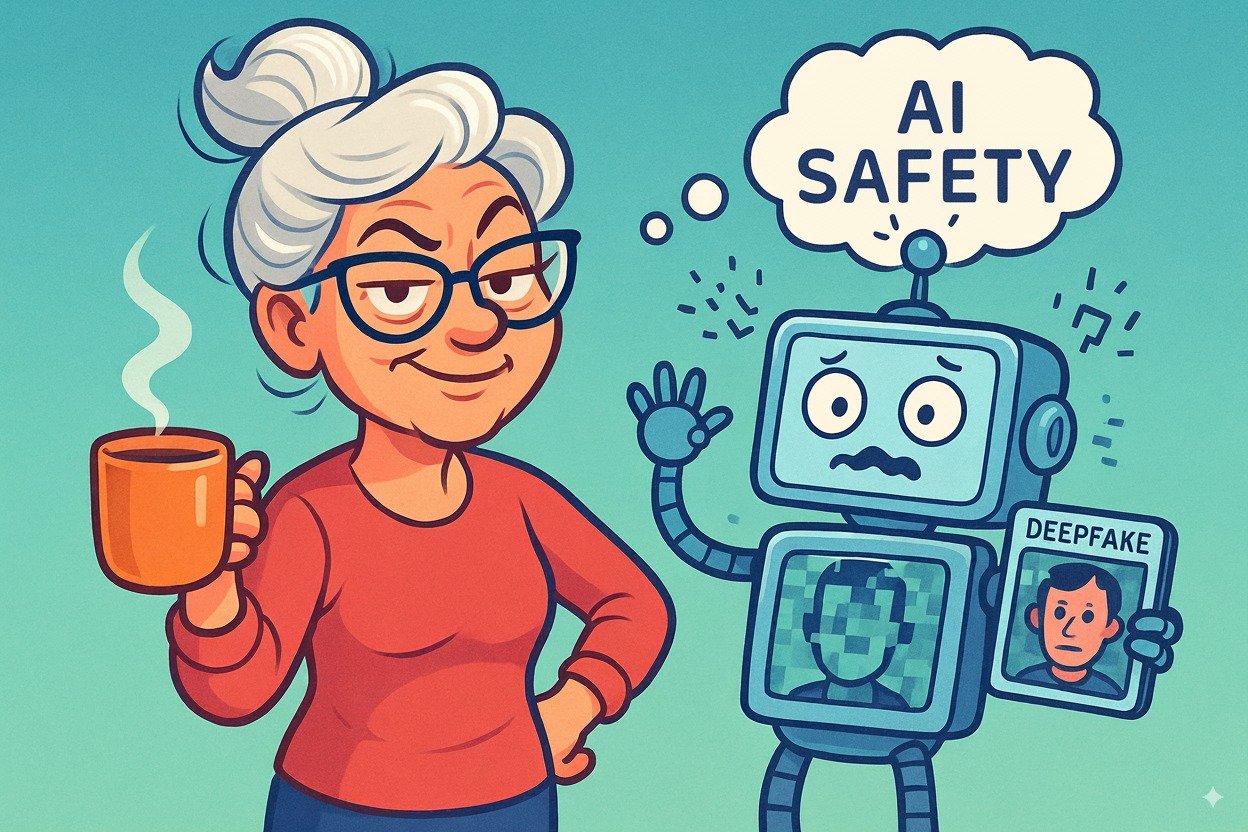
Newsletter Subscribe
Enter your email address below and subscribe to our newsletter


Remember when you could confidently tell the difference between a real person and, well, a particularly chatty parrot? Ah, simpler times!
Today, thanks to the magic and mischief of Artificial IntelligenceArtificial Intelligence (AI) is basically when computers get smart—really smart. Imagine if your c... More (AI), knowing who or what you’re talking to online—or even on the phone—has become a bit like trying to solve a riddle wrapped in an enigma, covered in gravy.
It’s confusing, it’s a little scary, and it’s definitely not as straightforward as it used to be.
You see, the digital world is getting smarter, but unfortunately, so are the folks who want to trick you.
AI is no longer just for fancy sci-fi movies or solving complex math problems. It’s now a tool in the hands of clever scammers, making their tricks incredibly convincing.
These aren’t your grandpa’s chain letters anymore; we’re talking about sophisticated digital illusions that can make a fake look astonishingly real.
But don’t you worry your well-earned gray hairs! You don’t need to become a cybersecurity expert overnight.
What you do need is a good map and a trusted guide to navigate this smart new world securely.
Think of this as your definitive, no-nonsense handbook to understanding AI threats, spotting the fakes, and protecting your digital self.
We’re here to give you the insider knowledge, the practical steps, and most importantly, the confidence to keep your wits about you and stay safe online.
It used to be that scams were pretty easy to spot. A Nigerian prince email, a distant relative needing money in a hurry, or a pop-up telling you you’d won a lottery you never entered.
Nowadays, thanks to AI, these old tricks have put on a digital disguise, becoming far more sophisticated and, frankly, much harder to ignore.
This isn’t just about a few bad apples; it’s a global phenomenon.
Cybercrime is a booming business, projected to exceed a staggering $10.5 trillion annually by 2025.
That’s enough money to buy… well, a lot of very fancy parrots.
And here’s a sobering thought: 87% of organizations reported experiencing at least one AI-powered cyberattack in the past year, with 93% expecting daily AI attacks very soon. This isn’t just a corporate problem; these attacks often target individuals as the weakest link.
AI has given scammers superpowers. It allows them to personalize messages with uncanny accuracy, create convincing fake images and videos (deepfakesDeepfake technology uses advanced artificial intelligence to swap one person’s face onto another i... More), and even mimic voices with just a tiny audio clip.
It’s an “AI arms race” where attackers are constantly finding new ways to exploit this technology, and we, as everyday users, need equally smart defenses.
But don’t despair! Your best defense isn’t a complex computer program, it’s knowledge and a healthy dose of digital skepticism.
Alright, let’s get down to brass tacks. How do you tell if that super-realistic email, video, or phone call is actually a wolf in AI clothing?
It’s all about knowing what to look for, much like checking a suspicious-looking mushroom before adding it to your dinner.

At a glance: Understand how common AI-generated scams differ, spot their red flags, and learn straightforward detection tactics to protect yourself.
Phishing emails aren’t new. But AI has put them on steroids. These aren’t just generic “you’ve won” messages anymore.
AI can scrape your social media, find out where you work, who your friends are, and even what you had for breakfast (if you posted a picture!). This allows it to craft incredibly personalized and convincing messages that hit all your emotional buttons.
Red Flags to Watch For:
Actionable Steps:
Imagine seeing a video of a famous person saying something totally out of character, or a picture of your grandchild in a place they’ve never been. That’s deepfake territory.
AI can create incredibly realistic fake videos and images by swapping faces, altering expressions, and even synthesizing entire scenes.
Deepfake fraud surged a shocking 1,740% in North America between 2022 and 2023, with over $200 million in losses in just the first quarter of 2025 alone.
Red Flags to Watch For:
Actionable Steps:
This one hits particularly close to home. AI can clone a voice from as little as a few seconds of audio—think voicemails, social media videos, or even news clips.
Scammers then use this cloned voice to call you, pretending to be a loved one in distress, often asking for money for an “emergency.”
This type of deepfake fraud led to over $200 million in losses in Q1 2025.
Red Flags to Watch For:
Actionable Steps:
Social engineering is essentially tricking people into giving up information or access. AI takes this to a whole new level by enhancing the psychological manipulation.
It can process vast amounts of data to understand your vulnerabilities, craft highly persuasive narratives, and trigger emotional responses like urgency, fear, or sympathy.
In fact, 42% of organizations suffered a successful AI-powered social engineering attack.
How AI Supercharges Manipulation:
Real-Life Examples:
The bottom line? If something feels off, or if a message plays heavily on your emotions, step back, take a deep breath, and use your critical thinking skills.
Knowing how to spot a scam is half the battle. The other half is building a strong defense so that you’re less likely to be a target in the first place.
Think of it like putting a good sturdy lock on your front door—it doesn’t stop all burglars, but it sure makes it harder for them!

Your personal AI safety blueprint: Step-by-step measures to secure your digital world and keep AI threats at bay with confidence.
Every time you post online, comment on social media, or even interact with certain apps, you’re leaving a digital breadcrumb.
AI can follow these crumbs to build a detailed profile of you, which can then be used to create hyper-personalized scams.
Stanford University highlights the systemic privacy risks, noting the massive scale of data collection and the potential for repurposing your information without consent.
Actionable Steps:
Smart devices—your voice assistant, smart thermostat, video doorbell, or even a fancy new smart TV—are incredibly convenient.
But they also come with microphones, cameras, and internet connections that can be exploited if not properly secured. They gather data, and sometimes that data can be used to understand your habits, routines, and even your voice.
Actionable Steps:
Some safety rules are timeless, but AI makes them even more critical. The average global cost of a data breach reached a staggering $4.9 million in 2025 (IBM), highlighting just how much is at stake.
Actionable Steps:
No matter how sophisticated AI gets, it still relies on us to make the final decision. This is where your human superpower—critical thinking—comes into play.

AI can generate persuasive content, but it can’t think for itself in the way a human can. It lacks common sense, intuition, and lived experience.
That’s why Forbes highlights critical thinking as your best weapon against the coming deepfake tsunami. Your brain is still the ultimate lie detector.
This is your golden rule. When something feels off, or you’re asked to do something unusual, PAUSE. Don’t act immediately.
A Simple Framework:
In an age of deepfakes and AI-generated news, it’s more important than ever to be a savvy media consumer.
You’re not alone in this. Talk to your friends and family about AI scams. Share what you’ve learned.
The more people who are aware and vigilant, the stronger our collective defense against these threats. Encourage open discussion and report anything suspicious to the authorities or relevant platforms.
While human skepticism is paramount, there are also tools emerging that can help.
Many companies, like Grammarly and Copyleaks, offer AI detection tools that can identify AI-generated text.
However, the effectiveness of these tools varies, and they often struggle with sophisticated AI content. For example, leading deepfake detectors show accuracy drops of 45-50% in real-world conditions compared to labs.
This is a rapidly evolving area, and we’re constantly monitoring the best options for everyday users. In the future, we plan to offer a detailed guide comparing these tools, helping you understand their strengths and limitations.
For now, remember that no tool is foolproof, and your critical thinking remains your most reliable defense.
It’s completely normal to have questions and concerns about navigating this new digital landscape. Here are some common ones we hear:
AI has gotten incredibly good, but usually, there are still subtle tells. For voices, listen for robotic tones, unusual pauses, or inconsistent emotions. For visuals, look for strange blinks, skin textures, or distorted backgrounds. It’s often “almost perfect” but not quite.
Yes, with caution! Smart devices offer great convenience. The key is to be proactive: manage your privacy settings, use strong unique passwords, and keep the device’s software updated. If you’re concerned about a specific device, research its privacy features or consult our smart home devices section.
Practice the “Pause and Verify” mindset. Don’t react immediately to urgent requests or surprising information. Always take a moment to independently verify the source and the information before taking any action.
Don’t panic, but act quickly.
Contact your bank or financial institution immediately if money was involved.
Change all your passwords if you suspect any accounts were compromised.
Report the scam to relevant authorities (like the FTC or FBI in the U.S.).
Inform friends and family so they don’t fall for similar traps.
AI technology is evolving at an astonishing pace. This guide covers the fundamental principles and current common threats, which remain relevant. However, we are committed to regularly updating our content to reflect the latest trends and detection methods, ensuring you always have the most current information.
The world of AI is moving faster than a squirrel with a nut addiction, but with knowledge and a healthy dose of skepticism, you can stay ahead of the curve. You don’t need to be a tech wizard; you just need to be smart, aware, and a little bit suspicious when something seems too good (or too bad) to be true.
Here at Senior Tech Cafe, we believe technology should empower you, not intimidate you. By understanding these AI safety measures, you’re not just protecting yourself, you’re becoming a more confident, savvy digital citizen. You’re building your own digital fortress, brick by mindful brick.
We’re here to be your trusted advisor every step of the way. So, take these insights to heart, share them with your loved ones, and keep exploring our resources to stay updated. Together, we can navigate this smart new world securely, confidently, and perhaps even with a chuckle or two.